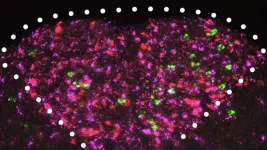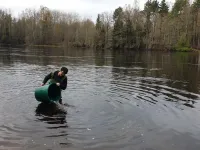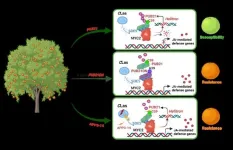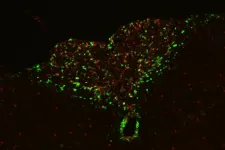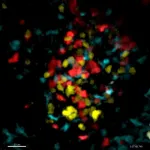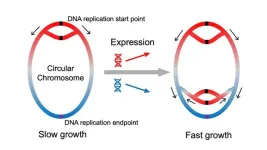(Press-News.org) A fossil Pleistocene-age hominin jawbone discovered in Taiwan has now been identified as belonging to a Denisovan, according to a new paleoproteomic analysis of the remains. The findings provide direct molecular evidence that Denisovans occupied diverse climates, from the cold Siberian mountains to the warm, humid subtropical latitudes of Taiwan, and offer new morphological insights into this enigmatic hominin lineage. Recent research has revealed a surprising variety of ancient human relatives that lived in eastern Asia during the Pleistocene before modern humans arrived. One of the most important discoveries is the Denisovans, a distinct group identified through DNA from fossils in Denisova Cave, Siberia. Studies show that Denisovans were closely related to Neanderthals and interbred with both them and modern humans. However, outside Siberia, direct genetic evidence of Denisovans has only been found on the Tibetan Plateau. While other fossils found across eastern Asia have been proposed as being Denisovan, their classification remains uncertain without molecular confirmation. Here, Takumi Tsutaya and colleagues provide paleoproteomic evidence identifying a fossil hominin mandible (Penghu 1) recovered from the Penghu Channel off Taiwan as belonging to a male Denisovan. The Penghu remains, along with various animal fossils, were retrieved through commercial fishing dredging from the seafloor, which was once part of the Asian mainland during lower sea levels in the Pleistocene. Using ancient proteomic analysis, Tsutaya et al. extracted proteins from bone and dental enamel from the fossil and retrieved 4,241 amino acid residues, two of which were Denisovan-specific protein variants. According to the authors, these variants are rare in modern human populations but have a higher frequency in regions associated with Denisovan genetic introgression. What’s more, morphological analysis of the Penghu 1 remains reveals a robust jaw structure with large molars, and distinctive root structures, features that align with traits seen in the Tibetan Denisovan specimen, suggesting these traits were characteristic of the lineage and perhaps sex-specific.
END
Pleistocene-age Denisovan male identified in Taiwan
Summary author: Walter Beckwith
2025-04-10
ELSE PRESS RELEASES FROM THIS DATE:
KATRIN experiment sets most precise upper limit on neutrino mass: 0.45 eV
2025-04-10
Researchers from the KATRIN (Karlsruhe Tritium Neutrino) experiment report the most precise measurement of the upper mass limit of the neutrino to date, establishing it as 0.45 electron volts (eV) – less than one-millionth the mass of an electron. The findings tighten the constraints on one of the universe’s most elusive fundamental particles and push the boundaries of physics beyond the Standard Model. Neutrinos – electrically neutral elementary particles – are the most abundant particles in the universe and ...
How the cerebellum controls tongue movements to grab food
2025-04-10
By studying the skilled movements of marmoset tongues, researchers have discovered that Purkinje cells (P-cells) in a brain region called the cerebellum signal to stop protrusion as the tongue approaches its target, according to a study published April 10th in the open-access journal PLOS Biology by Reza Shadmehr from Johns Hopkins School of Medicine, U.S., and colleagues.
We use our tongue to shape the air and generate sounds to communicate, and we use our tongue to evaluate food morsels and transport them through the oral cavity when eating. These skillful acts involve coordination of more ...
It’s not you—it’s cancer
2025-04-10
Cancer ravages both body and mind. If you’ve ever lost loved ones to the disease, you might recognize the physical and emotional changes cancer patients often endure during their final months. They seem drained of strength and spirit. Even people who’ve maintained a positive outlook throughout their lives can enter a state of despair. New research published in Science suggests apathy and lack of motivation are symptoms of a condition called cancer cachexia. Cold Spring Harbor Laboratory ...
Drug pollution alters migration behavior in salmon
2025-04-10
In the largest study of its kind to date, a team of international researchers has investigated how pharmaceutical pollution affects the behaviour and migration of Atlantic salmon.
The study, led by the Swedish University of Agricultural Sciences, revealed that commonly detected environmental levels of clobazam – a medication often prescribed for sleep disorders – increased the river-to-sea migration success of juvenile salmon in the wild.
The researchers also discovered that clobazam shortened the time it took for juvenile salmon to navigate through two hydropower dams along their migration route – obstacles that typically ...
Scientists decode citrus greening resistance and develop AI-assisted treatment
2025-04-10
In a groundbreaking study published in Science, a research team led by Prof. YE Jian from the Institute of Microbiology of the Chinese Academy of Sciences has identified the first mechanism of citrus resistance to citrus greening disease, or huanglongbing (HLB).
Utilizing artificial intelligence (AI), the team has also developed antimicrobial peptides that offer a promising therapeutic approach to combat the disease. This discovery addresses a long-standing challenge in the agricultural community—the absence of naturally occurring HLB-resistant genes in citrus.
Citrus ...
Venom characteristics of a deadly snake can be predicted from local climate
2025-04-10
Local climate can be used to predict the venom characteristics of a deadly snake that is widespread in India, helping clinicians to provide targeted therapies for snake bite victims, according to a study publishing April 10 in the open-access journal PLOS Neglected Tropical Diseases by Kartik Sunagar and colleagues at the Indian Institute of Science.
Russell’s viper (Daboia russelii) is found across the Indian subcontinent and is responsible for over 40% of snake ...
Brain pathway links inflammation to loss of motivation, energy in advanced cancer
2025-04-10
The fatigue and lack of motivation that many cancer patients experience near the end of life have been seen as the unavoidable consequences of their declining physical health and extreme weight loss. But new research from Washington University School of Medicine in St. Louis challenges that long-held assumption, showing instead that these behavioral changes stem from specific inflammation-sensing neurons in the brain.
In a study published April 11 in Science, the researchers report that they identified a direct connection between cancer-related inflammation ...
Researchers discover large dormant virus can be reactivated in model green alga
2025-04-10
Researchers had been studying the green alga Chlamydomonas reinhardtii for decades without seeing evidence of an active virus within it — until a pair of Virginia Tech researchers waded into the conversation.
Maria Paula Erazo-Garcia and Frank Aylward not only found a virus in the alga but discovered the largest one ever recorded with a latent infection cycle, meaning it goes dormant in the host before being reactivated to cause disease.
“We’ve known about latent infections for a long time,” said Aylward, associate professor in the Department of Biological Sciences. ...
New phase of the immune response uncovered
2025-04-10
The research groups led by Wolfgang Kastenmüller and Georg Gasteiger employed innovative microscopy techniques to observe how specific immune cells, known as T-cells, are activated and proliferate during a viral infection. Their findings revealed novel mechanisms: the immune system amplifies its defense cells in a far more targeted way than previously believed.
T-Cells Proliferate and Specialize During the Immune Response
T-cells are crucial defense cells in the immune system. To effectively ...
Drawing board rather than salt shaker
2025-04-10
Bioinformaticians from Heinrich Heine University Düsseldorf (HHU) and the university in Linköping (Sweden) have established that the genes in bacterial genomes are arranged in a meaningful order. In the renowned scientific journal Science, they describe that the genes are arranged by function: If they become increasingly important at faster growth, they are located near the origin of DNA replication. Accordingly, their position influences how their activity changes with the growth rate.
Are genes distributed randomly along the bacterial chromosome, as if scattered from a salt shaker? This opinion, which is held by a majority of researchers, has ...
LAST 30 PRESS RELEASES:
Do hormones explain why women experience more gut pain?
New materials conduct ions in solids as easily as in liquids
Breakthrough of the Year: Renewable energy begins to eclipse fossil fuel-based sources
LLM use is reshaping scientific enterprise by increasing output, reducing quality and more
Introducing LightGen, a chip for ultra-fast, ultra-efficient generative AI
Astronomers see fireworks from violent collisions around nearby star
ACC/AHA issue new guideline on managing congenital heart disease in adults
Cosmic crash caught on camera
Is talented youth nurtured the wrong way? New study shows: top performers develop differently than assumed
Ants: An untapped resource in the development of antibiotics?
Archaeologists use AI to create prehistoric video game
Mitochondria migrate toward the cell membrane in response to high glucose levels
Tiny viral switch offers hope against drug-resistant bacteria
Most parents aware of early peanut introduction guidelines, but confused about details
HPV vaccine can protect against severe lesions of the vulva and vagina
Virtual care provision and emergency department use among children and youth
Quadrivalent HPV vaccine and high-grade vulvovaginal lesions
Insights into dry eyes gained from stem cell-derived tear glands
Researchers identify 166 human pluripotent stem cell lines available for use in clinical applications
Europa Clipper instrument uniquely observed interstellar comet 3I/ATLAS
UN University Report challenges climate change as sole trigger of Syrian Civil War, exposing governance failures in drought response
Real estate investment trust (REIT) acquisition associated with hospital closure and bankruptcy
New Raman imaging system detects subtle tumor signals
Boston Children’s receives a $7.5 million grant from Aligning Research to Impact Autism (ARIA) to provide clinical research coordination for the IMPACT Network
Spray-on antibacterial coating offers new protection for plants against disease and drought
ESMT Berlin study: What makes a first offer successful in negotiations
Groundbreaking ceremony marks the beginning of CTAO-South Array construction in Chile
Why swearing makes you stronger
What prevents more cancer patients from enrolling in potentially life-saving clinical trials?
UK’s worst-case climate risks laid bare for lawmakers
[Press-News.org] Pleistocene-age Denisovan male identified in TaiwanSummary author: Walter Beckwith

